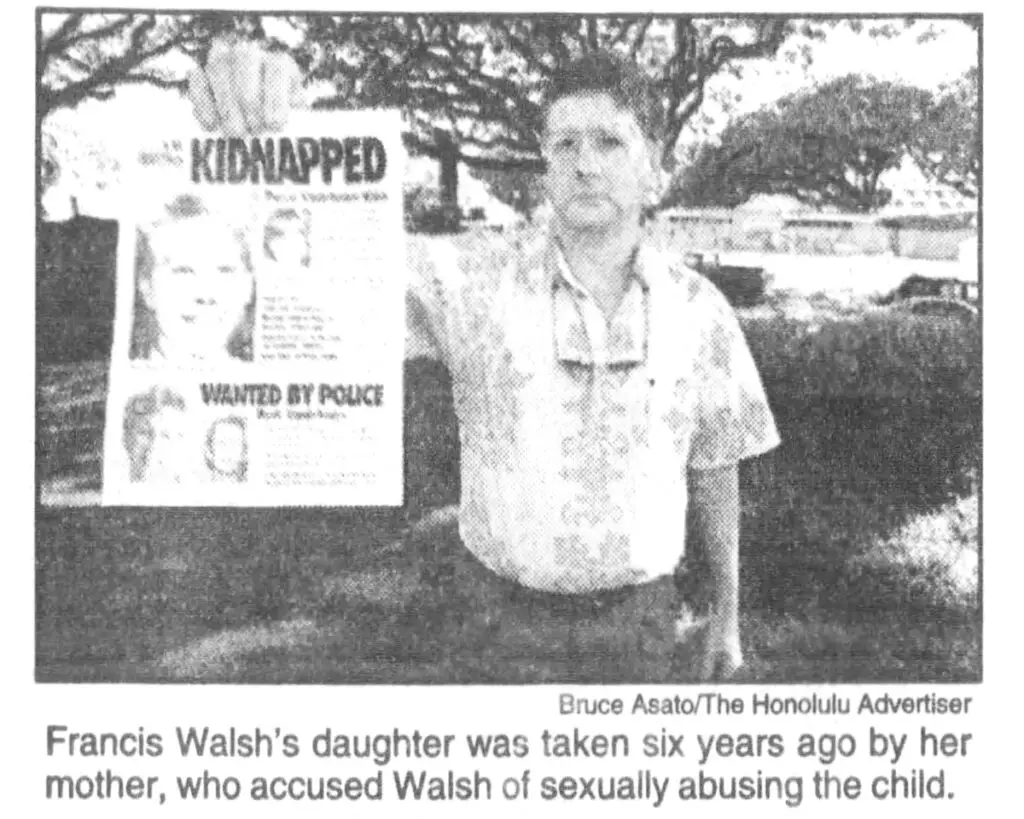On June 22, 1990, Therese Rose Vanderheiden-Walsh’s noncustodial mother, Merle Marie Vanderheiden, 39, kidnapped Therese while she attended the Kokokahl YWCA in Kaneohe, Hawaii. Therese, 5, resided with her father, Francis Walsh, and stepmother, Janice Walsh, in Kailua.
He and Merle met in the U.S. Army while stationed at Fort Meade, Maryland, in November 1979. She was a first lieutenant, and he was a major. Both were trained in military counterintelligence. Francis had recently divorced after a 10-year marriage.
“The old rebound,” Francis told The Honolulu Advertiser in May 1996. “I asked her out. I was probably feeling lonely.”
The couple married in September 1980 at the army base chapel. Merle left military service in May 1982, and a few months later, Francis transferred to Huntsville, Alabama.
On July 4, 1984, Merle gave birth to their daughter, Therese Rose. A year later, the army transferred Francis to Hawaii. His marriage was falling apart, but Francis believed the move would change things.
But the couple fought so severely that Francis lived in his car for four months. Francis and Merle separated in May 1987. A few months later, Merle accused Francis of sexually abusing Therese. He filed for divorce in January 1988, and it was official by January 1989.
Francis set out to prove his innocence in the abuse claim by enduring humiliating tests to clear his name. Although the types of tests remain unclear, police could not confirm the accusations against him. Furthermore, Francis soon had unexpected help from a psychologist hired by his ex-wife.
Merle likely hoped the psychologist would lie on her behalf. She could not have expected the professional to conclude Therese suffered from “‘parental alienation syndrome’ – a form of brainwashing where a child comes to believe one parent is evil and the other is good,” wrote Mike Gordon in The Honolulu Advertiser.
Family Court Judge Frances Wong awarded Therese’s father custody and noted Merle’s “unpredictability and a flagrant disregard for the child’s needs.” Merle failed to show up at the court hearing. Additionally, Wong did not allow unsupervised visits and ordered Merle to undergo psychiatric evaluation.
Merle appealed the custody ruling twice, but the Hawaii Supreme Court ultimately denied the appeal. She then attempted to get the case moved to a Federal court. A hearing was scheduled for July 16, 1990, before U.S. Judge Harold Fong, but Merle never showed, and Fong dismissed the case.
Meanwhile, Francis found love again with his third wife, Janice Walsh. When Therese came to live with them, Janice said, “she looked like a refugee.” Merle had chopped off the little girls’ hair but did a horrible job, cutting it down to the scalp in places.
Francis and Janice quickly realized therapy would help Therese, and they tried to give her an ordinary, decent life. She attended elementary school; they gave her pets and fun birthday parties.
They could never have imagined the extremes Merle would reach to get her revenge for losing custody.
On the morning of June 22, 1990, Therese, dressed in pigtails, white shorts, and tennis shoes, left home with her father. He was taking her to the YWCA for the day. At noon, daycare officials called Francis and told him Therese was gone.
Per The Charley Project, “Her teacher noticed a woman wearing dark sunglasses and a hat near the grounds while the students filed back into the center after recess ended. The teacher realized that Therese had disappeared after her classmates took their seats in their room.”
Police have long believed Merle was the woman who abducted Therese and that her family assisted in hiding them.
Merle resided in Texas, and Francis worried she would flee Hawaii with Therese. Family and friends flew to the airport and staked out each security checkpoint and Mainland departure, looking for Merle and Therese. They stayed until 1:30 a.m. but never saw the two. They likely fled on another day.
Soon, the police and FBI became involved in Therese’s abduction. But Merle, knowledgeable and military-trained, knew how to live off the grid and elude authorities. She used several aliases and wore wigs to hide her identity. It would have been much easier in 1990 than today.
Authorities issued a felony interference with custody warrant for Merle’s arrest on July 26, 1990.
Police discovered the family had purchased a Ford van for Merle after she vanished, putting the name “Mary Jean Hamm” as the owner on the title. It was one of Merle’s aliases. Merle later sold the van in 1994 to her sister-in-law. When police discovered the sale and investigated, someone had wiped the van clean of fingerprints.
Investigators traced Merle to various states, including Colorado, Florida, and Texas.
Francis hired a private investigator during the first summer his daughter was gone. The P.I. traveled to Colorado to spy on Merle’s sister, Mary Kim Vanderheiden, but found no evidence Therese had been there.
The following summer, Francis and his brother, a retired New York cop, staked out Merle’s family in Texas, hoping Merle and Therese would show. But the Neighborhood Watch chased them away. Then, at 7-Eleven, Merle’s big, bad brothers approached their car, so Francis and his brother fled.
Interestingly, yet unsurprisingly, Merle’s parents and siblings denied assisting her in Therese’s abduction. They believed the garbage Merle fed them about Francis molesting Therese.
Her father, Merle J. Vanderheiden, 73, in 1996, told Gordon, “We hope she is OK. But if she is on the run, more power to her.”
Dorothy Vanderheiden, then 66, said, “It is horrible, but it is better than if we knew Fran had her still. He is not a sane man.”
Of the Ford van, Merle’s parents claimed there was a mixup, and the FBI was out to harass them.
When Gordon tracked down Mary Kim to interview her, she freaked.
“How did you find me? I really don’t trust anybody. Why do you consider this important? We have been harassed by Mr. Walsh. I won’t speak to anybody as it relates to Mr. Walsh.”
In late 1995, investigators discovered a woman named Marie A. Vandherheiden, who looked much like Merle, living in Colorado. Mary Kim resided in Colorado at the time and was a school principal. There is no doubt she helped her sister and niece stay hidden.
According to Gordon, Marie A. Vanderheiden spoke at an American Bar Association conference in Denver. Authorities compared photos and driver’s licenses and believed Marie and Merle were the same.
But the FBI screwed up. When they ran a fingerprint check on Marie, it came back negative. That’s because agents submitted Therese’s prints instead of Merle’s. Nevertheless, a follow-up investigation cleared Marie.
Some believe Faye Yager, who founded the “Children of the Underground” network, helped Merle flee with Therese. If so, Merle would have told her the same sob story – Francis abused Therese.
Merle has eluded investigators for 33 years. She is now around 73, and Therese is 39.
Dorothy Vanderheiden died in 2012. She was 82. The family listed Merle and Therese as surviving family members but gave no location, of course. I believe the two are in Colorado or Texas. I have no idea if Merle is alive or dead.
Unfortunately, life proved unfair on several occasions for Francis. He died at 53 in September 1998 following a heart attack.




